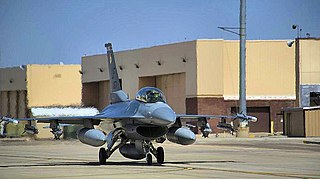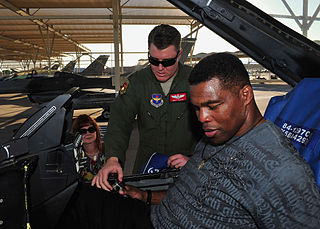
Luke Air Force Base is a United States Air Force base in Maricopa County, Arizona, United States. It is located 7 miles west of the central business district of Glendale, and 15 miles west of Phoenix.

The 71st Fighter Squadron is an active squadron of the United States Air Force, part of the 1st Operations Group of the 1st Fighter Wing. Stationed at Joint Base Langley–Eustis, Virginia, the squadron serves as a training unit, flying the F-22 Raptor.

The 54th Fighter Squadron is an inactive United States Air Force unit. Its last assignment was to the 3d Operations Group, being stationed at Elmendorf Air Force Base, Alaska. It was inactivated on 28 April 2000.

The 62d Fighter Squadron is part of the United States Air Force 56th Operations Group at Luke Air Force Base, Arizona. It operates the Lockheed Martin F-35A Lightning II aircraft conducting advanced fighter training.

The 63d Fighter Squadron is an active United States Air Force unit, assigned to the 56th Operations Group, at Luke Air Force Base, Arizona. It operates the F-35A aircraft, and conducts advanced fighter training since its reactivation in 2016. When this Squadron was reactivated in 1975, their mission was to train pilots and weapons systems officers for the McDonnell F-4E Phantom II, and they switched to the F-4D in 1978.

The 69th Fighter Squadron is a United States Air Force Reserve fighter squadron. It is assigned to the 944th Operations Group, stationed at Luke Air Force Base, Arizona.

The 309th Fighter Squadron is part of the 56th Operations Group at Luke Air Force Base, Arizona. It operates the F-16 Fighting Falcon aircraft conducting advanced fighter training.

The 310th Fighter Squadron is part of the 56th Operations Group at Luke Air Force Base, Arizona. It operates the Lockheed Martin F-35A Lightning II, conducting advanced fighter training.

The 311th Fighter Squadron (Sidewinders) is part of the 54th Fighter Group at Holloman Air Force Base, New Mexico which is a geographically separated unit under the 56th Fighter Wing at Luke Air Force Base, Arizona. It operates the General Dynamics F-16 Fighting Falcon aircraft conducting advanced fighter training. The squadron previously operated the Fighting Falcon conducting advanced fighter training at Luke and was inactivated due to budget constraints after the end of the Cold War. It was recently reactivated at Holloman and the aircraft were received from the 309th Fighter Squadron.

The 113th Air Support Operations Squadron is a unit of the Indiana Air National Guard 181st Intelligence Wing located at Terre Haute Air National Guard Base, Indiana.

The 550th Fighter Squadron is an active United States Air Force unit. Its current assignment is with 56th Operations Group, at Kingsley Field, Oregon.

The 31st Combat Training Squadron is an active United States Air Force unit. It is currently assigned to the Nevada Test and Training Range at Nellis Air Force Base, Nevada.

The 46th Fighter Training Squadron is an inactive United States Air Force unit. Its last assignment was with the 917th Operations Group at Barksdale Air Force Base, Louisiana. where it was inactivated on 1 October 1993.

The 56th Operations Group is a unit of the United States Air Force, and the flying component of the 56th Fighter Wing.

The 56th Training Squadron is an active United States Air Force unit. It is assigned to the 56th Operations Group at Luke Air Force Base, Arizona.
The 4706th Air Defense Wing is a discontinued United States Air Force (USAF) organization. Its last assignment was with the 37th Air Division of Air Defense Command (ADC) at O'Hare International Airport (IAP), Illinois where it was discontinued in 1956. It was established in 1952 at O'Hare as the 4706th Defense Wing in a general reorganization of Air Defense Command (ADC), which replaced wings responsible for a base with wings responsible for a geographical area. It assumed control of several Fighter Interceptor squadrons that had been assigned to the 142d Fighter-Interceptor Wing, an Air National Guard wing mobilized for the Korean War and the 56th Fighter-Interceptor Group. In early 1953 it also was assigned six radar squadrons in the Midwest and its dispersed fighter squadrons combined with colocated air base squadrons into air defense groups. The wing was redesignated as an air defense wing in 1954. It was discontinued in 1956 and most of its units transferred to the 58th Air Division.

The 4708th Air Defense Wing is a discontinued United States Air Force organization. Its last assignment was with the 30th Air Division of Air Defense Command (ADC) at Selfridge Air Force Base (AFB), Michigan, where it was discontinued in 1956. It was established in 1952 at Selfridge as the 4708th Defense Wing in a general reorganization of Air Defense Command (ADC), which replaced wings responsible for a base with wings responsible for a geographical area. It assumed control of several fighter Interceptor squadrons that had been assigned to the 56th Fighter-Interceptor Wing, some of which were Air National Guard squadrons mobilized for the Korean War.

The 575th Air Defense Group is a disbanded United States Air Force organization. Its last assignment was with the 4708th Air Defense Wing at Selfridge Air Force Base, Michigan, where it was inactivated in August 1955. The group was originally activated as the 575th Air Service Group, a support unit for the 4th Fighter Group after the 4th returned to the United States at the end of World War II and performed that mission until it was inactivated in 1947.

The 72nd Fighter Squadron is an inactive United States Air Force unit. Its last assignment was with the 56th Operations Group, based at MacDill Air Force Base, Florida. It was inactivated on 19 June 1992.

The 56th Fighter Wing is a fighter wing in the United States Air Force. It is the world's largest Lockheed Martin F-35 Lightning II wing and one of two Air Force F-35 training locations. Additionally, it is one of two active-duty F-16 training bases. The 56th graduates dozens of F-35 and General Dynamics F-16 Fighting Falcon pilots and 300 air control professionals annually.































